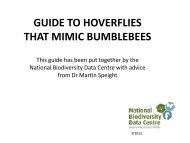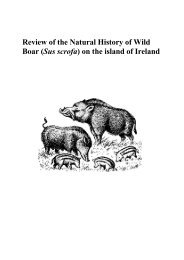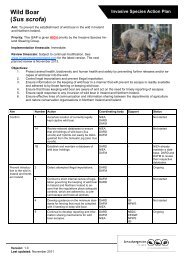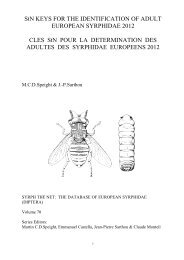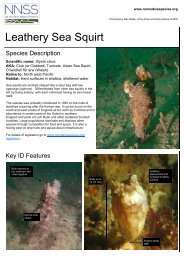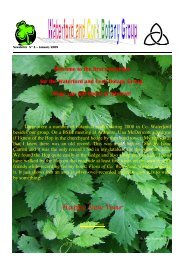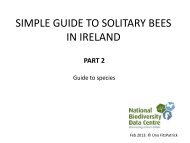StN DATABASE: CONTENT AND GLOSSARY OF ... - Pollinators
StN DATABASE: CONTENT AND GLOSSARY OF ... - Pollinators
StN DATABASE: CONTENT AND GLOSSARY OF ... - Pollinators
Create successful ePaper yourself
Turn your PDF publications into a flip-book with our unique Google optimized e-Paper software.
Pinus sylvestris (gen.), coniferous forests: forests of scots pine (Pinus sylvestris), with stands of<br />
overmature, mature and young (saplings/scrub) trees.<br />
CORINE 42.5: SCOTS PINE FORESTS; forests dominated by Pinus sylvestris.<br />
Pinus sylvestris, conifer plantations: CORINE 83.3112: EUROPEAN PINE PLANTATIONS<br />
Populus (gen.), deciduous plantations: CORINE 83.3211: POPLAR PLANTATIONS WITH<br />
MEGAPHORB HERB LAYER; Old poplar plantations with a tall herb-rich undergrowth, substitution<br />
habitat for some riparian forest species of plants and animals.<br />
Populus, scattered trees in open ground: see scattered trees in open ground (gen.).<br />
Quercus, scattered trees in open ground: see scattered trees in open ground (gen.).<br />
Quercus/Carpinus/Ulmus (gen.), deciduous forests: oak/hornbeam (Quercus/ Carpinus) forests, with<br />
stands of overmature, mature and young (saplings/scrub) trees: CORINE 41.2.<br />
CORINE 41.2: OAK-HORNBEAM FORESTS; Carpinion betuli; Atlantic and medio-European forests<br />
dominated by Quercus robur or Q.petraea, on eutrophic or mesotrophic soils, with usually ample and<br />
species-rich herb and bush layers. Carpinus betulus is generally present. They occur under climates too<br />
dry or on soils too wet or too dry for beech or as a result of forestry practices favouring oaks.<br />
Quercus ilex (gen.), broad-leaved, evergreen forests: forest dominated by Quercus ilex or<br />
Q.rotundifolia, with stands of overmature, mature and young (saplings/scrub) trees: CORINE 45.3.<br />
Species associated with Q.ilex scrub, which could fall into CORINE 32311 (see under high maquis) are<br />
coded in the Macrohabitats table both under Quercus ilex saplings (macrohabitat category 1613) and<br />
under high maquis (macrohabitat category 12321).<br />
Quercus pyrenaica, (gen.), deciduous forests: Quercion robori-pyrenaicae: Q.pyrenaica-dominated<br />
forests of the Iberian peninsula and, locally, south-western France. CORINE 41.6<br />
Quercus suber (gen.), broad-leaved, evergreen forests: western-Mediterranean silicolous forest<br />
dominated by Quercus suber, with stands of overmature, mature and young (saplings/scrub) trees:<br />
CORINE 45.2; usually more thermophile and hygrophile than Q.ilex-dominated forest.<br />
Quercus/Ulmus/Fraxinus, alluvial hardwood forest: diverse riparian forests of the middle courses of<br />
great rivers, inundated only by large floods and with stands of overmature, mature and young<br />
(saplings/scrub) trees: CORINE 44.41<br />
CORINE 44.41: MEDIO-EUROPEAN FLUVIAL FORESTS Querco-Ulmetum minoris; fully<br />
developed, very tall, multilayered, highly diverse riparian forests of oaks, ashes, elms, limes, maples,<br />
alders, poplars, cherries, apple, willows of the middle and lower courses of large medio-European river<br />
systems, in particular, the Rhine, the Danube, the Ernst, the Elbe, the Saale, the Weser, the Loire, the<br />
Rhône-Saône systems. Their highly complex structure is formed of eight strata to which participate up<br />
to 50 species of trees and shrubs. The upper arborescent stratum includes Quercus robur, Fraxinus<br />
excelsior, Ulmus minor, U. laevis, U. glabra, Populus alba, P. tremula, P. canescens, P. nigra,<br />
Acerpseudoplatanus, platanoides, Salix alba, Alnus glutinosa, Prunus avium, the lower arborescent<br />
stratum Malus sylvestris, Tilia cordata, the sub-arborescent shrub layer Alnus incana, Prunus padus<br />
and Crataegus monogyna. There are very varied high and low shrub layers and numerous lianas,<br />
Clematis vitalba, Tamus communis, Humulus lupulus, Hedera helix and Vitis vinifera ssp. sylvestris.<br />
Most diverse, structurally, floristically and faunistically, of all European ecosystems, and closest in that<br />
respect to tropical communities and to the warm temperate forests of the Pleistocene, the great fluvial<br />
forests of Europe are reduced to a few highly vulnerable examples, located mainly within the Rhine,<br />
Danube and Elbe systems.<br />
raised bog, bog: CORINE 51.1: NEAR-NATURAL RAISED BOGS; undisturbed, or little<br />
disturbed, peat-forming bogs, often taking the shape of a convex lens. Such intact or nearly intact<br />
systems have become very rare or even exceptional. They are composed of a number of communities,<br />
which form and occupy the topological features of the bog. These communities are interrelated and<br />
function as a unit, so that they cannot be regarded as separate subhabitats; their presence and<br />
combination, however, characterise the various types of bogs. Typically, fen/acid fen communities<br />
occur round the outer edge of the bog, where its water-supply is maximally influenced by ground-<br />
34



